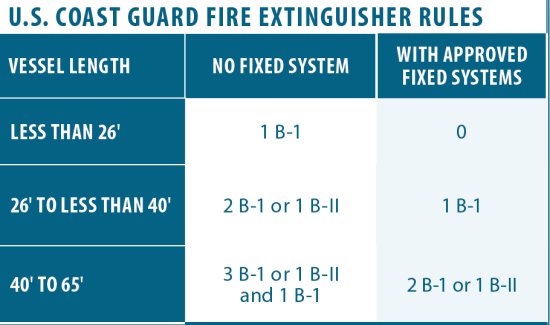Spraying water on a fire seems pretty crude, but having a water-mist extinguishers (Class A:C) presents a few interesting advantages. Before jumping on the water-beats-fire bandwagon, it’s important to understand the types of fires likely to occur on a cruising sailboat.
Class A: Wood, paper, cloth, trash, plastics
- The numerical rating for a Class A Fire extinguisher refers to the amount of chemicals/agent in the extinguisher. The number represents the chemical/agent’s equivalent to gallons of water the extinguisher holds. For a water mist extinguisher, multiply the number in front of A by 1.25 to figure out the equivalent in gallons of water.
- Example: A mist fire extinguisher with a rating of 2A would contain the equivalent to 2.5 gallons of water (2 x 1.25) and weighs about 24 pounds (1 gal. = 8 lbs.). For comparison, a dry chemical fire extinguisher with a 2A:10B:C rating will contain about 5 pounds of monoammonium phosphate and weigh about 8 pounds.
Class B: Flammable Liquids-Gasoline, oil, grease, acetone (includes flammable gases)
- The numerical rating for a class B fire extinguisher refers to the number of square feet that the fire extinguisher will be able to extinguish.
- Example: A fire extinguisher with a rating of 1A:10B:C would contain agents equal to 1.25 gallons of water (1 x 1.25) and would be able to extinguish 10 square feet of a class B fire.
(The extinguisher would also be rated non-conductive due to the C rating).
Class C: Electrical Fires, Energized electrical equipment fires (anything that is plugged in)
- The C classification does not carry numerical rating. When “C” is present in the classification/UL rating, it indicates that the agents in the fire extinguisher are non-conductive, meaning that you can use them on an electrical fire (meaning anything that is plugged in).
- Example: A fire extinguisher with a rating of 5B:C would be able to extinguish 5 square feet of a class B fire and could also be used on a Class C fire (electrical) due to its non-conductive properties.
Class D: Metal fires involving magnesium, sodium, potassium and sodium-potassium alloys
- Class D fire extinguishers are generally not given a numerical rating. They are simply classified as a “Class D” extinguisher.





































